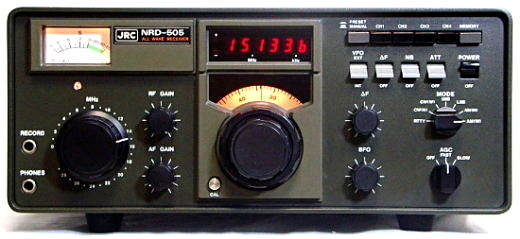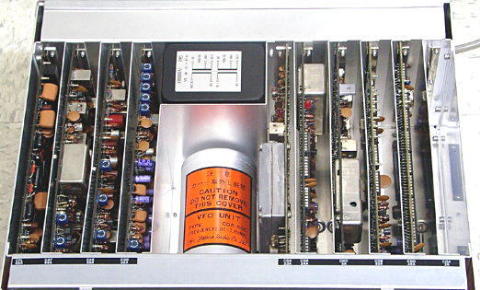
JRC NRD-505 HF Receiver (1977~79)
"Is it the great lost perfect set ? Probably not, but it sure is fun to use"..........Paul Bigelow
(N9EWO Photo Edit)
|
Japan
Radio Co.
JRC |

JRC NRD-505 HF
Receiver (1977~79)
"Is it the great
lost perfect set ? Probably not, but it sure is fun to
use"..........Paul
Bigelow
(N9EWO
Photo Edit)
The Japan Radio
NRD-505
receiver was built between 1977 and 1979 and was not produced in
large numbers (about 1000). For those days the steep price tag of
almost $ 2300.00 USD was very hard for any consumer to afford. It's
matching NVA-505 speaker and 4 channel memory board (CD4-8) unit
were both options. No internal speaker. It used a PTO tuning
circuit, just as the Drake R-7/TR-7 sets of that day did . But
the PTO used in the 505 put the Drake's to shame (MUCH better
built) ! And of course the drift factor in the Drakes were
nasty....505's had no such of a excessive problem.
4 channel memory option stored frequency only. A collectors
set theses days as any more modern device will be a MUCH
better deal (and performance) then any overpriced used
NRD-505's. But for it's day it was a most interesting set. I have
never had the chance to even see one of these in person, however Paul
Bigelow fill us in with his comments below.
Keep in mind, with the NRD-505 being as old as they are now,
problems with the set are very common, and the custom made parts
needed to repair can no longer be purchased (well at least easy). One
also has to remember that the NRD-505 uses nylon gearing with it's main
tuning control to the PTO. Age is never good for any plastic like this.
Dave N9EWO
© N9EWO, all rights reserved
Ver 2.2

Information from Paul
Bigelow on his NRD-505. Thank You Paul.
Physical - Constructed like other JRC receivers. Robust, solid and with
vertical cards that plug into a motherboard. Each card is
separated by a shield. All aluminum construction for panels and
chassis. Knobs are plastic. The VFO is (probably) permeability
tuned much like the old Collins equipment.
Reception - (compared with AOR AR7030):
Sensitivity - about equal, the JRC has slightly reduced
sensitivity below 1600kc. The JRC may be a bit better on SW bands.
Selectivity - good, the AOR is a bit better but the narrow
mechanical filter of the JRC works well. The narrow CW filter
works very well. The filters can be adjusted so the JRC
performance may be improved upon. All in all though, the AOR is
better.
Sound - JRC, but not horrible. It is a bit hissy but the noise is
NOT coming from the amplifier but the IF amp, I think. Since
someone mis adjusted the IF gain to maximum gain (not good) the
noise can be reduced with proper IF gain adjustment. The AOR AR7030
wins (of course).
Overload - A bit of overload on Longwave from AM stations and on
the 14MC band from STRONG 7MC stations. Again, proper adjustment
of the mixers may help in this regard. Still, not bad. The AOR AR7030
is better.
Birdies - A few small ones but have not tried a REAL test yet.
The JRC will probably win in this regard.
Tuning smoothness -- very smooth in places, 10 revolutions for
each 1MC band. It uses nylon gears
fitted with anti-backlash
gears.
One big BEWARE concerning the construction of the NRD-505. The
connections from the chassis to the front panel is not by ribbon
cable (like the NRD-525) but rather by flexible ribbon film found
today in camcorders and cameras. VERY high-tech for the day (1977)
but with age it can get fragile and is difficult to repair. Mine
has no problems but the slightest nick in the film or a wayward
drop of solder could lead to a BIG headache.
The 4-channel memory seems to work well, if a bit crudely by
today's standards. It only stores the frequency -- no mode
information. It does have a provision for keeping the memory when
the set is unplugged via a battery (on the circuit board, like
the NRD-525).
The bandwidths are:(3 filter slots)
- 6kc - Ceramic filter AM-wide. Sounds pretty good -- not the
highest sound quality but not too bad either.
- 2.2kc - Mechanical filter SSB and AM-narrow. Works well with
SSB. AM is pretty muffled but intelligible.
- .6kc -(option) Mechanical filter CW. Works
well with Morse code and provides a quiet background.
There is also an audio filter that switches in during CW mode and
maybe SSB that restricts the audio highs and lows and reduces the
hiss.
The mode selects the filter but there are positions for AM-Wide,
AM-Narrow, USB, LSB, CW-Wide, CW-Narrow, RTTY.
Found the correct battery for the memory card. $8.50 -- ouch!
Silver oxide camera battery.
Is it the "great lost perfect set"? Probably not, but
it sure is fun to use.
NRD-505 Owners Manual (via shortwaveradio.ch)
Paul Lannuier's "General Information About the NRD-505 HF Receiver"
NRD-505 Schematics (via RadioPics web page)
Paul Lannuier - "NRD-505 Circuit Description (sorry no pictures)"
JRC Amateur and SWL gear (groups.io)